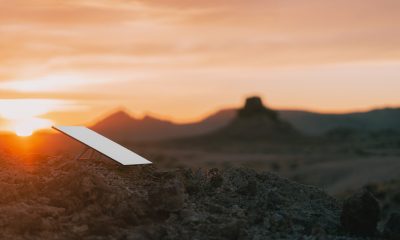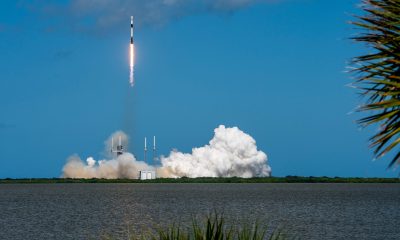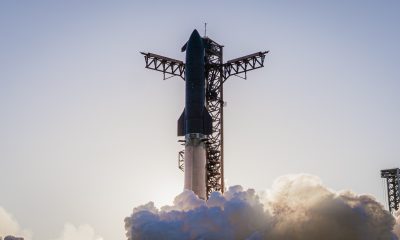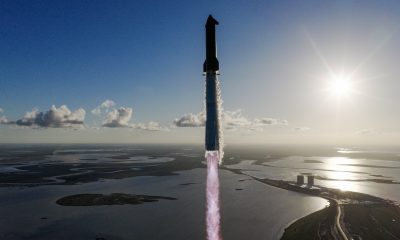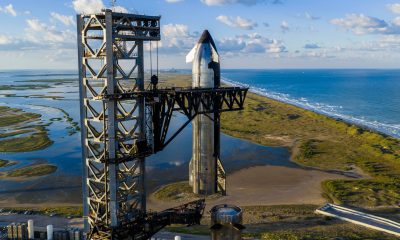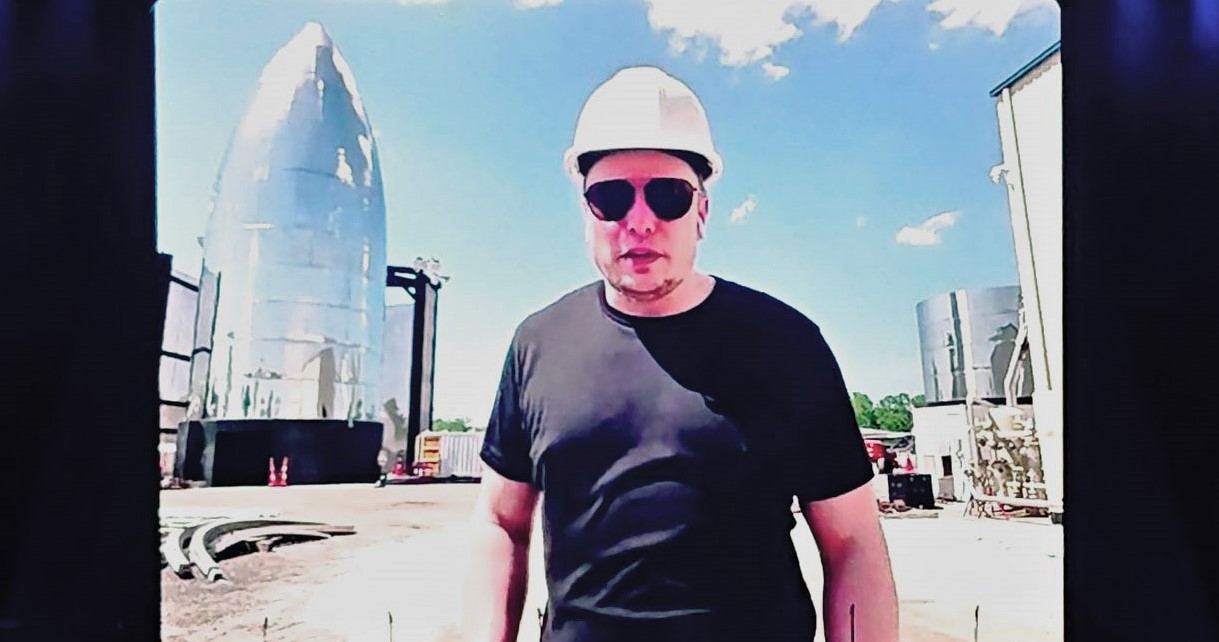
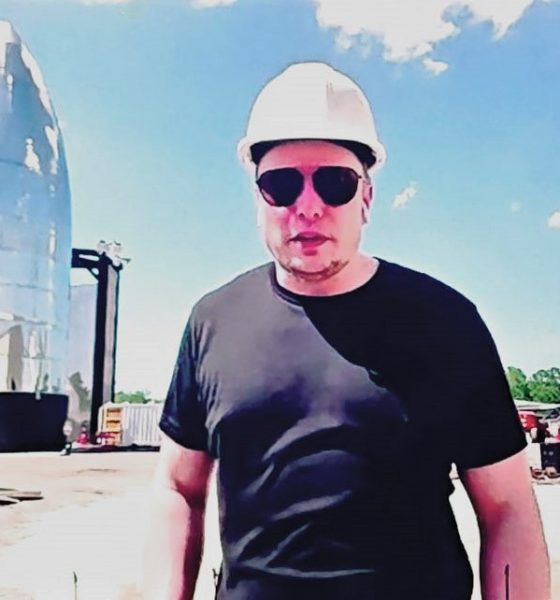
News
SpaceX CEO Elon Musk & Raptor engine make surprise visit to Florida Starship
While on the East Coast for Falcon Heavy’s third launch, also described as SpaceX’s most difficult launch yet, CEO Elon Musk dropped by the company’s Florida Starship campus and recorded a small acceptance speech for his 2019 Stephen Hawking Medal.
On the very same day, at the very same site, a lone Raptor was effectively displayed for all to see to such an extent that unaffiliated photographers were able to capture impressively detailed photos. Almost the certainly the first time a full-scale Raptor has traveled east of Texas, the engine’s presence at SpaceX’s Florida Starship site is truly surprising in light of the fact that the East Coast campus is solely focused on building orbital-class prototypes. Why, then, is one of SpaceX’s small handful of completed Raptors in Florida?
About a month ago, Elon Musk was announced as the recipient of 2019’s Stephen Hawking Medal of Science Communication. Meant to be awarded in person at a ceremony in Switzerland, Musk was unable to attend the event due to a schedule conflict with Falcon Heavy’s third launch, but the infamously busy CEO managed to film a brief thank you message that was then broadcast in Switzerland.
In what seems to be a coincidence, Musk’s message – either recorded or streamed – was filmed on SpaceX’s Florida Starship development campus, a surprisingly large facility uncovered less than two months ago. The CEO was standing in the sun directly in front of two large segments of the second orbital-class Starship prototype, part of a parallel development process featuring a second Starship prototype (and separate Starhopper) in Texas. Musk’s appearance at Starship Florida is not particularly surprising; if he flew all the way to Florida for Falcon Heavy, might as well tour SpaceX’s newest Florida facilities on the same trip.
Raptor Mystery: Episode II
What is surprising, however, is the presence of what looks like a finished Raptor engine in Florida. Looks can certainly be deceiving but SpaceX’s Florida Starship prototype – while undeniably flying through preliminary assembly – does not appear to be anywhere near flight-readiness. In Boca Chica, a partially separate SpaceX team is working to prepare Starhopper – a partial-fidelity, suborbital prototype – for low-altitude, low-velocity hop tests

Back in May, a mystery Raptor engine – believed to be serial number 04 (SN04 – appeared in South Texas and was soon installed on Starhopper for fit-checks and tests of the engine’s thrust vectoring capabilities. SN04 was soon uninstalled and shipped elsewhere; perhaps to SpaceX’s rapidly-progressing Florida Starship. If the surprise Florida Raptor is, in fact, SN04, then it’s safe to assume that it will remain inert for the time being, serving as a fit-check article and opportunity for training and familiarizing technicians and build engineers. At the moment, Florida’s Starship lies in several large segments, including what appears to be the early stages of its first propellant tank bulkhead(s).
Nevertheless, as partially demonstrated above, SpaceX’s Florida team is wasting no time at all. By all appearances, they are rapidly catching up with Texas, at least as long as Boca Chica’s Starhopper work is excluded. Given the benefit of the doubt, SpaceX Texas would likely be at a similar stage of Starship develop after a similar amount of time (~2-3 months), but much of the Boca Chica workforce has been focused intently on building, upgrading, and testing Starhopper, essentially a flying testbed for Raptor and BFR development.
To an extent, Florida’s orbital Starship prototype looks even more refined than its relatively rugged Texas cousin. Given an additional 1-2 months of nonstop work and a rate of progress similar to the last two months, it’s not out of the question that the Florida prototype will begin to seriously resemble a finished Starship. By all realistic accounts, some of the most difficult work will be found inside and around Starship’s finished aeroshell, though, and the process of outfitting avionics, plumbing the propellant/propulsion sections, and implementing hydraulic/actuation systems will be a huge amount of work.

Even after Starship East is effectively complete, SpaceX will still face the seemingly immense challenge of transporting a massive spacecraft that weighs several dozen tons and measures 9m (30 ft) in diameter and 60m (200 ft) tall from Cocoa to Pad 39A, a full 20-30 miles of public roads and highways. In fact, the easiest method of transporting may involve getting Starship onto a barge in the nearby Indian River and towing it 100+ miles by water to the beach adjacent to Pad 39A. Regardless, neither method is going to be quick or easy and both will put on quite a show for local observers.
Check out Teslarati’s Marketplace! We offer Tesla accessories, including for the Tesla Cybertruck and Tesla Model 3.
News
Tesla Model Y on FSD saves couple after encountering King of edge cases
Experts have noted that if confirmed, this could be the world’s first recorded meteorite collision involving a Tesla.
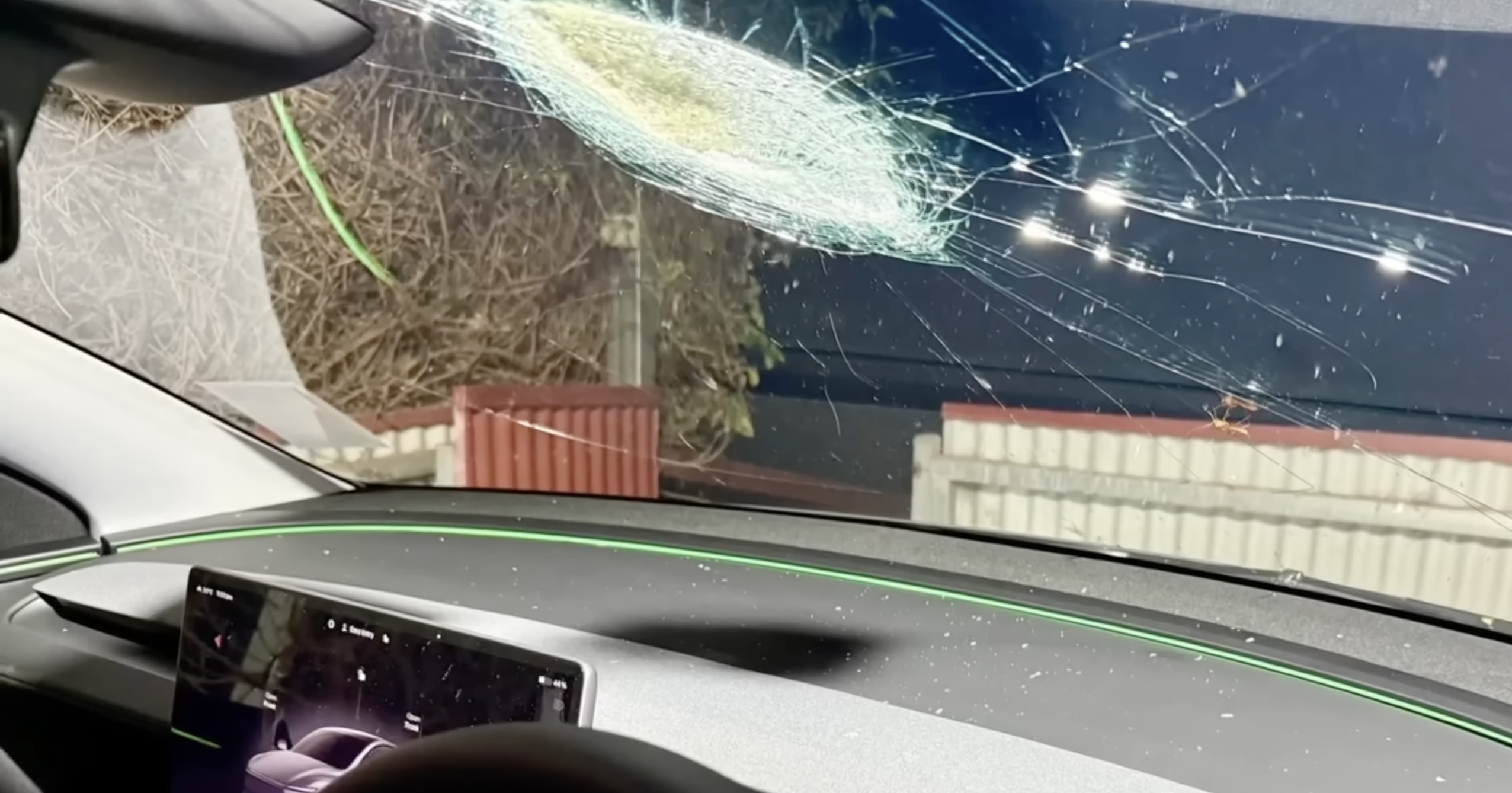
A South Australian Tesla driver is thanking his Model Y’s Full Self-Driving system after a mysterious object, possibly a meteorite, slammed into his car’s windshield while it had FSD engaged.
The impact sent hot glass fragments flying through the cabin as the vehicle continued driving without human input through the darkness. Experts have noted that if confirmed, this could be the world’s first recorded meteorite collision involving a Tesla.
The Tesla owner was enjoying a quiet drive home when they hit the king of edge cases
Veterinarian Dr. Andrew Melville-Smith and his wife were traveling north on Augusta Highway on the night of October 19 when a sudden blast struck their newly delivered Model Y. At the time, it was clear, pitch black night, and Dr. Melville-Smith and his wife were just listening to a podcast while FSD was operating the vehicle, as noted in a Yahoo News report.
Suddenly, something hit the Tesla’s windshield. “Then there was, (what) I can only describe as a very, very violent explosion. The whole inside of the car was literally blasted with glass fragments. It was full of white smoke, and it smelled like the car was on fire,” Dr. Melville-Smith stated.
The vet stated that he and his wife were stunned for a good 10 seconds, and for a bit, he and his wife thought they had crashed. Images of the crash’s aftermath showed a massive crack on the Tesla’s windshield, which Dr. Melville-Smith noted was hot to the touch. The object that hit the Tesla’s windshield was so hot that part of the vehicle’s windshield was partly melted.
FSD kept driving despite the possible meteorite strike
Thankfully, the Tesla was operating with its FSD (Supervised) system engaged at the time. Thus, despite the vehicle being hit by what might be a literal meteorite, and despite Dr. Melville-Smith and his wife being stunned because of the impact, their Tesla just kept driving steadily.
“I thought we’d had an accident, but then I looked at the screen and went ‘Oh, we’re still driving. We were moving around, so it obviously thought we were paying attention, and it was happy to keep driving to Port Augusta. After we pulled over, we saw the big crater in the windscreen,” the vet said.
The South Australian Museum is now examining the case, with geologist Dr. Kieran Meaney stating the scorched glass and heat damage do suggest a potential meteorite strike. “The little detail that’s really selling it for me at the moment is that whatever it was that hit the windscreen seems to have been very hot,” Meaney explained. However, the object has yet to be recovered.
Check out a video of the remarkable edge case below.
News
“Foundation:” Elon Musk wants to send a record of Grokipedia to space
The idea sounds outlandish, though it is also something that is in character for the CEO.
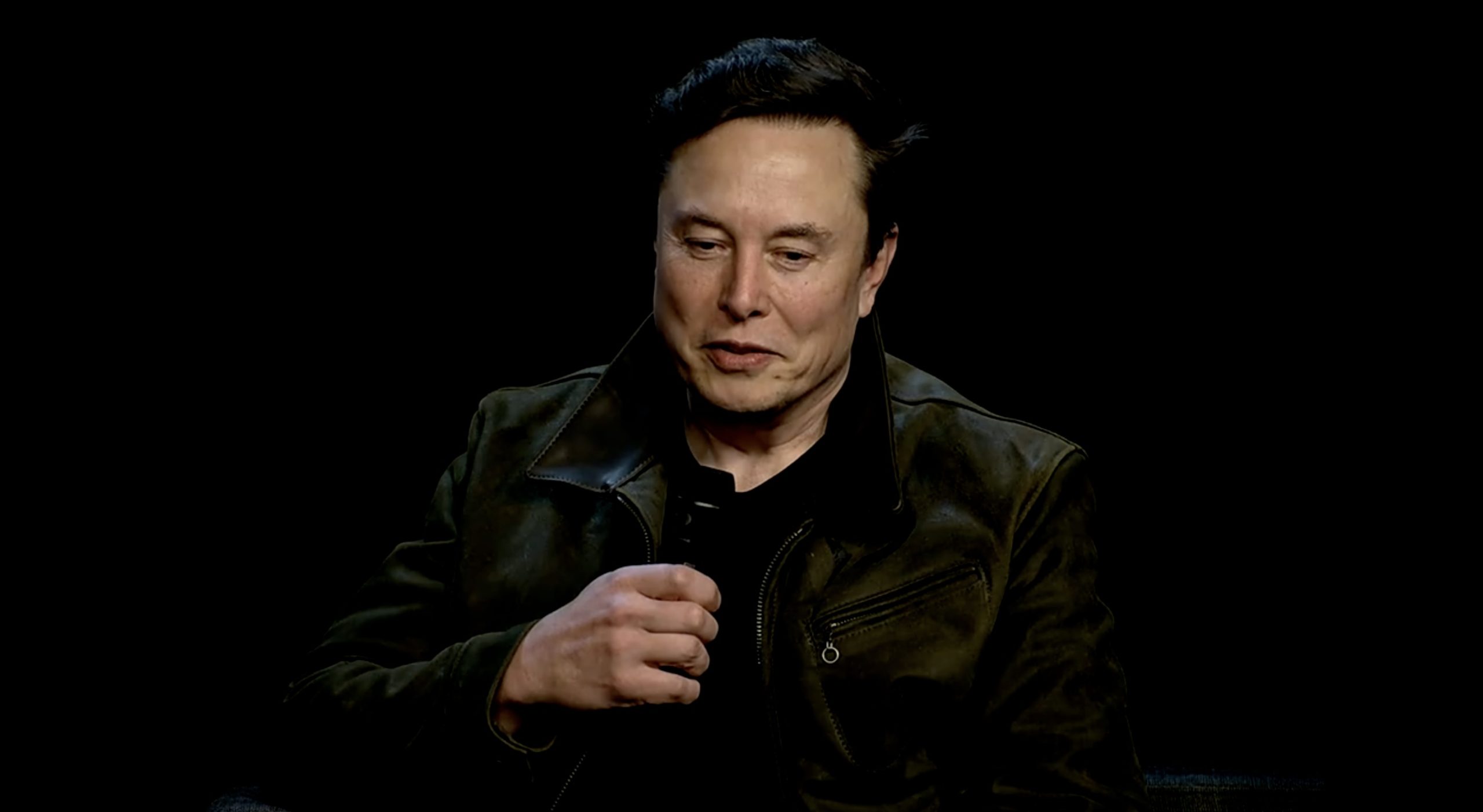
Elon Musk has announced one of his latest initiatives, and it is every bit as sci-fi as it is surprisingly grounded. In a post on X, Musk stated that Grokipedia, xAI’s new open-source encyclopedia, will be etched into stable oxide and launched into space.
The idea sounds outlandish, though it is also something that is in character for the CEO.
Preserving human knowledge among the stars
Musk posted his plan following the launch of Grokipedia’s V0.1’s iteration. The CEO congratulated the xAI team for the online encyclopedia’s launch, though he also stated that the goal for Grokipedia is to create an open-source collection of knowledge. This would then be distributed to the cosmos.
“Nice work by the xAI team on Grokipedia! The goal here is to create an open source, comprehensive collection of all knowledge. Then place copies of that etched in a stable oxide in orbit, the Moon, and Mars to preserve it for the future. Foundation,” Musk wrote in his post.
While seemingly outlandish, this is not the first time that a record of human knowledge of sorts was sent out to space. In 1977, the Voyager Golden Record was launched aboard NASA’s Voyager 1 and 2 spacecraft. The record contains sounds and images that ere aggregated to portray the diversity of the Earth’s culture. Of course, Musk’s plan with Grokipedia, is infinitely more ambitious.
Grokipedia and AI neutrality
Musk launched Grokipedia as an AI-driven alternative to Wikipedia, designed to eliminate the human biases that could affect conventional online knowledge platforms. The system is powered by xAI’s Grok, which scrape and summarize information from across the internet, offering balanced and nuanced coverage of topics ranging from science and technology to culture and politics.
Unlike Wikipedia’s human-edited format, Grokipedia would be able to evolve through machine learning, reading vastly more material than any editorial team could. Early testers, including Wikipedia co-founder Larry Sanger, praised its initial version as “very OK” and potentially more neutral than Wikipedia. Musk agreed, stating that even in its V0.1 form, Grokipedia is “already better than Wikipedia.”
News
Tesla Cybertrucks to save Las Vegas police thousands in fuel and maintenance
Sheriff Kevin McMahill unveiled the new vehicles on Monday, describing them as “the next evolution to keep our community safer than it’s ever been.”
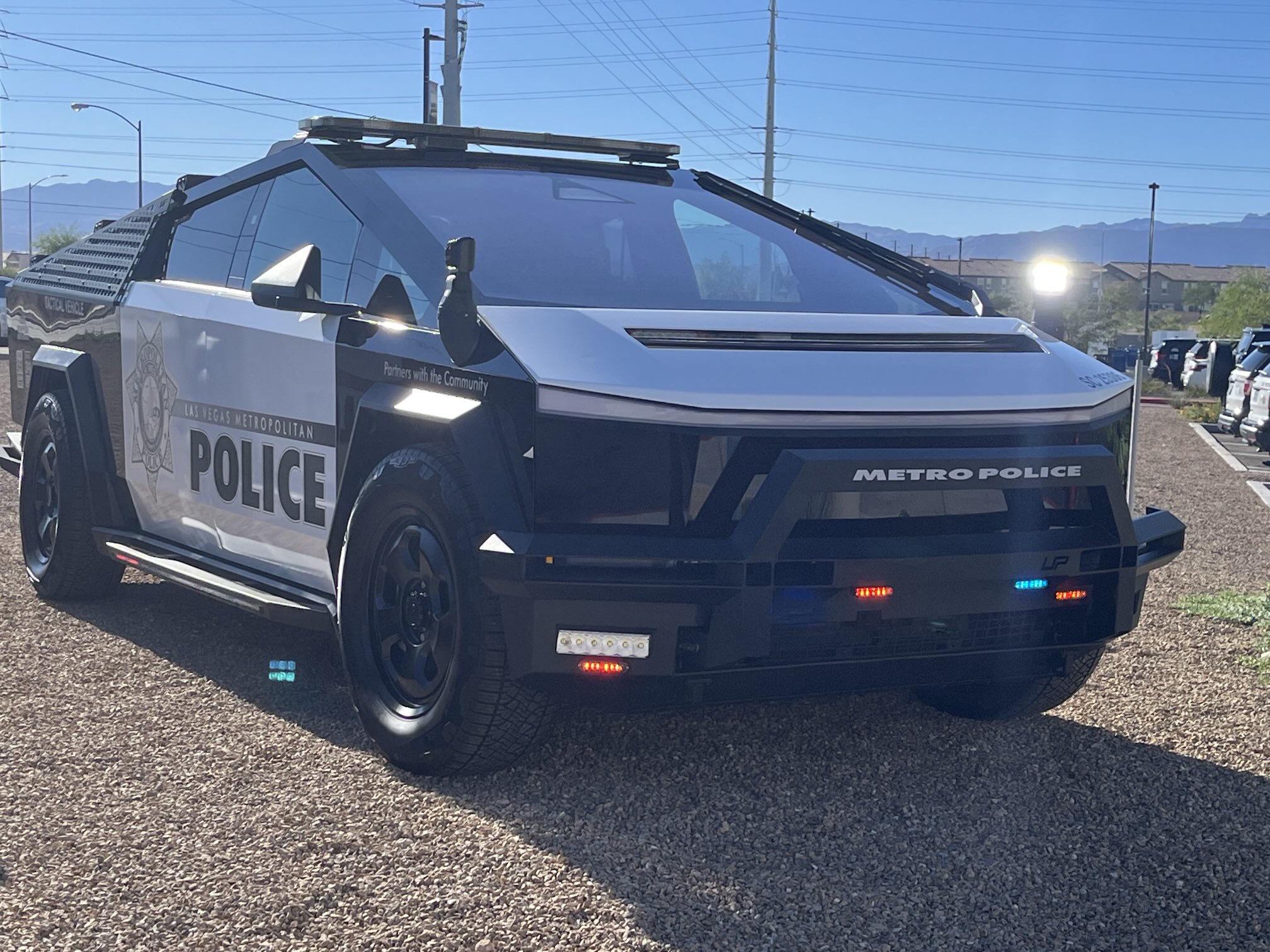
The Las Vegas Metropolitan Police Department has officially unveiled its fleet of Tesla Cybertrucks as part of its push toward a more advanced, cost-efficient, and sustainable patrol system.
Sheriff Kevin McMahill unveiled the new vehicles on Monday, describing them as “the next evolution to keep our community safer than it’s ever been.” The trucks are expected to begin service across all area commands within two weeks.
High-tech patrol fleet
Each UP.FIT-modified Cybertruck has been customized with ladders, shields, and less-lethal equipment to support law enforcement operations. The vehicles will connect to a live drone response hub capable of facial recognition and gunshot detection, enabling drones to launch automatically when alerts trigger. The system streams real-time footage directly to responding officers, enhancing both speed and situational awareness during emergencies.
Officers have already completed training with the new fleet and offered feedback on its performance, according to Fox 5 Vegas. Sheriff McMahill noted that the trucks, along with robot dogs and SWAT vehicles, represent a coordinated effort to combine human expertise with emerging technologies. The Cybertruck rollout was made possible through a donation from the Horowitz family.
Cybertrucks’ major savings
The department’s ten UP.FIT patrol Cybertrucks are among the most American-made law enforcement vehicles available, featuring roughly twice the domestic parts content of comparable Ford and Chevrolet patrol trucks. Beyond their build quality, the electric fleet offers major cost benefits. Each Cybertruck is projected to save between $8,800 and $12,000 in annual fuel costs and roughly $3,540 in maintenance over a five-year service life.
With regenerative braking, factory ballistic-resistant doors, and no idling fuel burn, the Cybertruck platform provides higher uptime, lower total cost of ownership, and a quieter patrol experience, all while reducing the department’s carbon footprint. Sheriff McMahill confirmed each area command will receive one of the new patrol units.
-

 Elon Musk2 weeks ago
Elon Musk2 weeks agoSpaceX posts Starship booster feat that’s so nutty, it doesn’t even look real
-

 Elon Musk2 weeks ago
Elon Musk2 weeks agoTesla Full Self-Driving gets an offer to be insured for ‘almost free’
-

 News2 weeks ago
News2 weeks agoElon Musk confirms Tesla FSD V14.2 will see widespread rollout
-

 News2 weeks ago
News2 weeks agoTesla is adding an interesting feature to its centerscreen in a coming update
-

 News2 weeks ago
News2 weeks agoTesla launches new interior option for Model Y
-

 News2 weeks ago
News2 weeks agoTesla widens rollout of new Full Self-Driving suite to more owners
-

 Elon Musk2 weeks ago
Elon Musk2 weeks agoTesla CEO Elon Musk’s $1 trillion pay package hits first adversity from proxy firm
-

 News1 week ago
News1 week agoTesla might be doing away with a long-included feature with its vehicles


